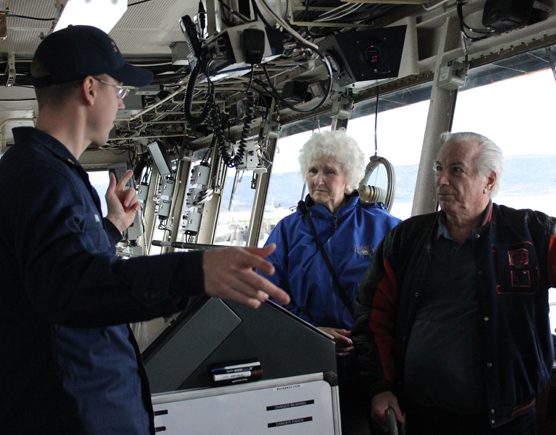BY MICHAEL ARMSTRONG
STAFF WRITER
Sign up.
That’s the message Susan Yeager, Alaska director of the U.S. Department of Veterans Affairs, delivered to lower Kenai Peninsula veterans during a September talk for the Kachemak Bay Rotary Club.
Fill out the VA’s form 1010EZ. Get enrolled. Help the VA help you.
With Veterans Day having been observed on Tuesday, Yeager’s message seems to take on even more significance.
Alaska has 77,000 military veterans, of which 30,000 haven’t enrolled to receive VA benefits. About 17,000 veterans statewide use the VA. The Kenai Peninsula has 5,512 veterans, with 2,517 enrolled and about 1,600 using benefits.
In the Homer area, 200 out of 341 vets use the VA.
“We’re trying to increase it more because we believe there are vets who need service,” Yeager said. “There are still veterans in this area who could have the benefit of the VA.”
Yeager, who has worked in the VA for 34 years, conceded the criticism the VA has received this year sparked by reports in Phoeniz, Ariz., that veterans had lengthy wait times to get medical care.
“That really took off. It was something I had never seen before — how weak was the VA, how it had to improve,” Yeager said. “The bottom line is access to health care for veterans.”
Because of Alaska’s geography and its lack of a large, centralized VA medical center, to some degree Alaska has already implemented one solution suggested for getting veterans medical care: purchasing care through non-VA health providers. The VA reimburses at Medicare plus rates.
“We in Alaska pretty much know how rural we are and the challenges of health care,” Yeager said. “When it came down to what happened in the lower 48, it had already happened in Alaska.”
In Anchorage, through a contract with the Department of Defense at its Joint Venture Hospital at Joint Base Elmendorf Richardson, the VA has 10 beds for intensive care and 24 beds for medical care. Anchorage also has a VA Outpatient Clinic. In Fairbanks, Kenai and the Mat-Su, the VA has Community Based Outpatient Clinics and in Homer and Juneau Outreach Clinics.
In Homer, Anchorage VA Dr. Roy Boone visits South Peninsula Hospital twice a week to do VA clinics. Through the hospital, the VA also does social work and mental health telemedicine clinics — like “Skype on steroids,” Yeager said.
The VA also has contracts with 26 Alaska Native health corporations to provide VA medical care, including Seldovia Village Tribe.
At the Seldovia SVT clinic, that means veterans can go to that clinic, but at the Homer SVT health clinic, because Dr. Boone already does clinics, the rules say veterans have to see him. However, waivers can be made on a case-by-case basis to access the Homer SVT clinic, Yeager said.
The Veterans Choice Bill signed by President Barack Obama will allow veterans to get non-VA care if they can’t get an appointment within 30 days. Since Alaska veterans already can get medical care through non-VA doctors, how that will roll out and affect Alaska veterans remains to be seen, Yeager said.
“We’re kind of up in the air for next year,” she said.
One way the VA signs up eligible veterans is when they go to hospital emergency rooms. Vets who get care there can sign up within 72 hours for benefits, but it’s better if they have already done that.
“That’s why we’re trying to be proactive,” Yeager said. “Just go ahead, get started.”
Veterans also can get emergency transportation services like medevacs. When she’s traveled to rural Alaska, Yeager said she would find veterans who didn’t know about that service.
“It hurts my feelings. We got out to the villages and found there are two veterans who had two medevacs for cardiac surgery,” she said.
At the local level, the VA also is trying to provide transportation for veterans to doctors or to the Homer outreach clinic and the Kenai outpatient clinic.
“This is a big issue,” Yeager said.
Some veterans use the VA as their primary medical provider, but the VA also can benefit veterans on other health insurance plans. The VA provides care for service-related injuries.
That’s the situation he’s in, noted VA public affairs officer Samuel Hudson. A Navy veteran, he has a service-related injury.
“I can go for the rest of my life for those injuries,” he said.
The VA also provides other benefits, such as burial services. Veterans who qualify for disability also can get benefits based on the degree of the disability.
Yeager comes from a military family. Her father was a radio operator in World War II and her brother was wounded in the Vietnam War. She said she understands why Vietnam-era veterans in particular might be hesitant to get VA service. She encouraged those veterans to talk to the VA.
“Give them another chance,” Yeager said. “We’d like to give them the opportunity to serve their needs.”
The poor treatment of Vietnam veterans has led to a better process for getting discharged veterans VA benefits. When veterans leave the service, the VA and Department of Defense work closely to advise them of VA benefits. The goal is to get them signed up using the 1010EZ form at discharge.
“I think we’re doing a lot better now as a country than we were during the Vietnam period,” Yeager said.
But to get help from the VA, those thousands of Alaska veterans who have served their country need to sign up.
“Now the VA is more. We believe this in Alaska. We exist for veterans,” Yeager said. “If they don’t know about you, how good are you?”
Michael Armstrong can be reached at michael.armstrong@homernews.com.


